Guidance on pigs with hernias
Learn how to care for pigs with hernias. This technical information is for commercial swine producers in Ontario.
ISSN 1198-712X, Published May 2021
Introduction
A hernia is an abnormal protrusion of an organ or tissue through a defect or natural opening in the covering skin or muscle. Hernias often cause welfare problems as well as economic loss.
Umbilical hernias in pigs occur when abdominal connective tissue fails to close around the umbilical ring. The condition may be hereditary, although the majority of umbilical hernias are related to infection of the umbilical cord.
Inguinal and scrotal hernias are congenital (present at birth) and can be significantly affected by genetic and environmental factors.
What to do for pigs with hernias
Federal and provincial legislation dictates that animals must be handled humanely. Enforcement agencies and the courts will use accepted industry standards and the law to determine which practices are not acceptable.
Pigs with hernias should be dealt with when they are young and hernias are small. Processors prefer not to receive pigs with hernias. However, animals with small intact hernias can be transported directly to slaughter. If the size of the hernia is questionable, please refer to the points listed under the Canadian Food Inspection Agency’s Interpretative Guidance for Regulated Parties.
In Ontario, there are a number of provincial slaughter plants that slaughter barbecue pigs (BBQ hogs), pigs with a dressed weight less than 45.36 kg (100 lb). Producers are encouraged to contact local provincial slaughter plants to make arrangements for slaughter. This provides producers with an outlet for the shipment of otherwise healthy pigs with small, intact hernias to these plants.
Know the law
The federal Health of Animals Act (Health of Animals Regulations, Part XII, Transportation of Animals — Regulatory Amendment) regulates the conditions under which animals may be transported. Under these regulations, it is a violation to:
- load, transport or unload animals in a manner that would cause injury or undue suffering
- crowd animals to such an extent as to cause injury or undue suffering
The Canadian Food Inspection Agency’s Interpretative Guidance for Regulated Parties provides a more detailed description of when an animal is fit or unfit for transport.
Producers also must be aware of the laws in Ontario regarding care, handling and transport of pigs. Specifically, the following laws apply to the care, handling and transport of pigs with hernias.
Provincial Animal Welfare Services Act (PAWS)
The Provincial Animal Welfare Services Act (PAWS) came into effect on January 1, 2020, replacing the Ontario Society for Prevention of Cruelty to Animals Act. PAWS is Ontario’s provincial animal protection legislation and prohibits an owner from permitting an animal to be in distress. Distress means that an animal is in need of proper care, water, food or shelter or is injured, sick or in pain, is suffering or is abused, or is subject to undue or unnecessary hardship, privation or neglect.
The presence of distressed animals is not consistent with reasonable and generally acceptable animal care practices. Falling below industry-accepted animal care standards could be considered permitting distress and may lead to enforcement action.
Food Safety and Quality Act — O. Reg. 31/05
Ontario’s Meat Regulation (O. Reg. 31/05) allows Ministry of Agriculture, Food and Rural Affairs (OMAFRA) veterinary inspectors to condemn or euthanize animals that are unfit for human consumption or that are exhibiting undue suffering or distress at provincially licensed slaughter plants. Pigs that arrive at provincial slaughter plants with ulcerated or infected hernias, hernias touching the ground, hernias that affect the way the animal walks with hind limbs touching the hernia or any sign of pain and suffering, will be held for veterinary inspection and may be condemned or euthanized.
O. Reg. 105/09
Ontario’s Disposal of Deadstock Regulation (O. Reg. 105/09) requires every person who has care of or control over a fallen animal to promptly destroy the animal in a humane manner or to make arrangements for it to be promptly and humanely destroyed. A fallen animal is one that is disabled by disease, emaciation or any other condition likely to cause death.
Pigs with very severe hernias that have become infected or injured may meet this definition.
The regulation also prohibits the movement of a fallen animal before it has been killed. This regulation is enforced by OMAFRA.
Livestock Community Sales Act
OMAFRA has the responsibility for monitoring the health and welfare of livestock at auctions in Ontario under the authority of the Livestock Community Sales Act.
Animals found that are diseased, injured or otherwise compromised at an auction can be ordered by OMAFRA veterinary inspectors to be any of the following:
- euthanized
- sent directly for slaughter
- sold with a ring announcement of the condition
- ordered returned to the consignor for treatment
Preventing hernias
Although the occurrence of scrotal and umbilical hernias is often a frustrating concern for commercial farms, there are several areas where the producer can try to reduce the incidence of hernias:
- Good sanitation and hygiene may be more likely to reduce the incidence of umbilical hernias than eliminating certain boars or dams. Disinfecting umbilical cords has been reported to decrease the incidence of infection.
- Improving farrowing-crate sanitation by removing accumulated sow manure before farrowing and using a desiccant powder to keep the crate floor dry may reduce bacterial levels in the piglets’ environment, thus reducing the risk of umbilical infection and umbilical hernias.
- Environmental factors such as abnormal stretching of the umbilical cord during farrowing, incorrect placing of navel clips or infection of the umbilical “stump” on the piglet could contribute to the failure of the umbilical cord opening to close correctly.
- In scrotal/inguinal hernias, careful pig handling can make a significant difference to herd incidence.
- As in all pig production, good stockmanship yields positive results.
Help with decision-making
The “Should This Pig Be Loaded” decision tree and “Information for Caring for Compromised Pigs” produced by Food and Farm Care Ontario (formerly the Ontario Farm Animal Council) are guidelines to help make pig loading and transport decisions.
If you are in doubt as to how a herniated hog should be dealt with and/or have questions about the severity of a hernia, please contact your swine veterinarian.
Assessment 1 - smaller hernias
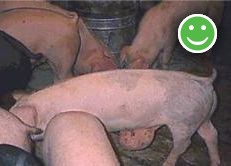
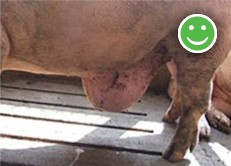
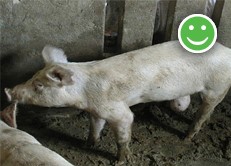
Assessment 2 - larger hernias
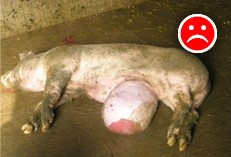
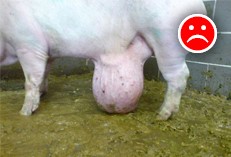
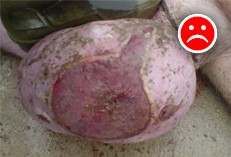
This fact sheet was authored by the Animal Health and Welfare Branch, OMAFRA.